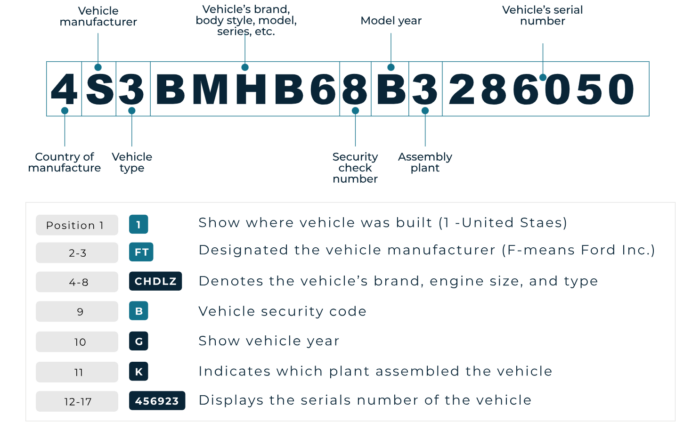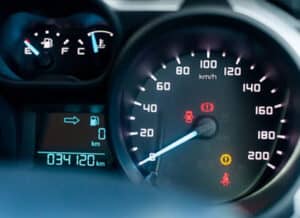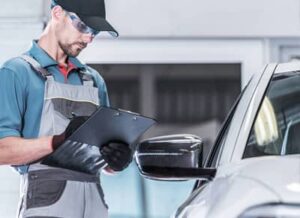Every car has a unique identifier called the Vehicle Identification Number (VIN). But where do you find it? Many people struggle to locate their car’s VIN, especially when they need it for vehicle history checks or registrations. This can lead to frustration.
Thankfully, knowing where to look can save you time and trouble. Let’s dive into where to find your VIN and why it matters.
What Is A Vehicle Identification Number (VIN)?
A Vehicle Identification Number (VIN) is a unique alphanumeric code assigned to every vehicle manufactured since 1981. This 17-character string combines both numbers and letters to create a distinctive identity for each car, truck, or motorcycle. Think of it as your vehicle’s fingerprint—no two vehicles share the same VIN.
The VIN serves multiple purposes. It helps identify the manufacturer, model, and year of the vehicle. It also provides important information about safety features and specifications. Additionally, the VIN plays a crucial role in tracking a vehicle’s history, including ownership changes, accident reports, and recall notices.
Where To Find The VIN Number On Your Car
Finding your VIN isn’t as hard as it sounds, even if you need to find your VIN number without your car. Here are some common places to check.
Check The Dashboard Of Your Vehicle
The most common location for the VIN is on the driver’s side dashboard. Look through the windshield at the corner where the dashboard meets the glass. You should see a small plate with the VIN. This spot is easy to access and is often the first place to check.
Look At The Inside Of Your Door Frame
Another common location is the driver’s side door frame. Open the door and look at the area where the door latches. There’s usually a sticker or metal plate displaying the VIN. This location makes it easy to find without needing to pop the hood or climb under the car.
Check The Engine Block
If you’re feeling adventurous, check the engine block. The VIN may be stamped on the engine itself. This location can be tricky to access, especially if you’re not familiar with car parts. However, it’s a reliable place to find your VIN, particularly if you suspect the car might have been tampered with.
Look At Your Car Insurance Card
You can often find the VIN on your car insurance card. Most insurers include the VIN on the policy documents. If you can’t find it on the car itself, your insurance paperwork might save the day. Just be sure to keep these documents handy.
Check Your Owner’s Manual
Your owner’s manual is another great resource. Many manufacturers include the VIN in the manual. If you have a digital copy, use the search function to locate it quickly. This method can help if you’re having trouble finding the VIN on the vehicle itself.
Call The Car Dealership Or Individual You Bought It From
If you bought your car from a dealership or an individual, don’t hesitate to reach out to them. They can provide you with the VIN if you can’t locate it yourself. This can save you time and provide peace of mind.
READ ALSO: How to Check a Trailer VIN Number
Why is VIN Number Important?
The significance of the VIN cannot be overstated; it serves multiple functions in vehicle ownership. First and foremost, it acts as an identifier for law enforcement agencies when they check for stolen vehicles. If someone attempts to sell a stolen car without its original documents, having access to its VIN allows authorities to trace its ownership back through history.
Moreover, knowing how to use your VIN helps identify recalls specific to your vehicle model. Manufacturers often issue recalls based on safety concerns; having this information at hand ensures that you’re not driving around in a potentially dangerous situation and a VIN can help you get it.
You can easily track ownership changes, liens, and loan records, maintenance history of a vehicle, and lot’s more. During vehicle registration, it is mandatory to include the VIN before submitting the application form to the Department of Motor Vehicles (DMV).
When you’re ready to sell or trade-in your vehicle, potential buyers will want to know its history too. Our comprehensive VIN check service allows both parties to verify that everything is checked out before finalizing any transactions.
Decoding The Characters In The VIN Number

Understanding what each character in a VIN means can be incredibly beneficial for any car owner. Each section of the 17-character code holds specific information about your vehicle:
- First Character: Indicates where the vehicle was manufactured.
- Second Character: Represents the manufacturer itself.
- Third Character: Identifies the type of vehicle—whether it’s a truck, SUV, or passenger car.
- Fourth through Eighth Characters: Provide details about features like engine type and body style.
- Ninth Character: Serves as a check digit used to verify that the number has been correctly entered.
- Tenth Character: Indicates the model year.
- Eleventh Character: Represents where in the production sequence this particular vehicle falls.
- Last Six Characters: Serve as a serial number unique to each individual unit.
Knowing how to decode these characters can provide insights into everything from safety features to performance specifications.
READ ALSO: How To Decode a 13 Digit VIN Number (Step by Step Guide)
Using The VIN Number To Track Car History
The ability to track a car’s history or classic car vehicle history using its VIN is one of its most valuable features. By entering this number into a VIN check tool, you gain access to comprehensive reports detailing past accidents, title issues, service records, and even odometer readings.
This information is important when considering whether to buy a used car or when selling one yourself. You want peace of mind knowing whether there are any hidden problems associated with that particular vehicle before making any commitments.
Additionally, if you’re ever involved in an accident or need repairs done on your car, having access to its full history can help mechanics understand what might need attention based on previous incidents.
How To Read A VIN Number On A Motorcycle
Motorcycles also have their own unique VINs, typically located in similar spots but sometimes requiring extra attention due to their design variations. Common areas include near the steering head or under the seat where manufacturers often place identification plates.
Motorcycle VINs can also be decoded to track vehicle history and specifications just like cars. So, if you’re considering buying a motorcycle, dirtbike, etc., don’t forget to get the VIN checked to identify hidden damages.
How To Protect Yourself From VIN Fraud
VIN fraud is a real concern. Scammers sometimes alter VINs to hide a vehicle’s true history. To protect yourself, always verify the VIN through a reliable service. Use a VIN check tool like the one available at Instant VIN Reports.
If something seems off—like an unusually low price paired with vague documentation—trust your instincts! Always insist on seeing physical proof of ownership before proceeding with any transactions involving used vehicles. This can help you avoid buying a vehicle with a shady past.
READ ALSO: What is a 2 axle vehicle? Learn everything you need to know!
Conclusion
In conclusion, recognizing how many VIN locations exist on a car helps ensure you’re well-prepared as a vehicle owner navigating today’s automotive landscape filled with complexities around ownership verification and safety concerns alike!
For more detailed insights into your vehicle’s history and peace of mind during transactions involving buying/selling cars alike consider utilizing Instantvinreports.com for comprehensive reports covering everything from accident histories down through recall information!
Frequently Asked Questions
Can I Check If I Have A Stolen Car Or If My Car Has Been In An Accident Using The VIN Number?
Absolutely! By using your VIN number, you can quickly check whether there are theft reports associated with it or if there have been any accidents recorded in its history.
How Do I Know If A VIN Number Is Valid?
A valid VIN consists of 17 characters without any letters I, O, or Q—these letters are omitted intentionally to avoid confusion with numbers 1 and 0 respectively. You can also verify its validity through various online tools designed specifically for this purpose.










